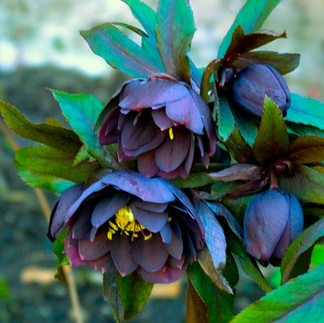What Are These Strange Beauties?
- Steven Hansen

- Jan 22, 2024
- 2 min read

Stunning white hellebores (Helleborus niger) have been pushing up through the snow in northern climes these past few weeks. This is not a freak accident of climate change. These extremely hardy flowers are also known as both Christmas rose and Lenten rose because of their seemingly miraculous ability to thrive and bloom in the coldest months, though they are not related to true roses at all. Instead, the 20 species of hellebores are members of the Ranunculus family, to which the simple yellow buttercup also belongs.

But these strange beauties possess odd powers, besides being able to survive and bloom in ice and snow. "Ranunculus helleborus" sounds ominous enough, like the spell from a Harry Potter story that would turn an attacking nemesis into ice, freezing him forever in mid-lunge. But the species’ name is just the beginning of their unusual story.
Aside from the glorious white version, other hellebore varieties bloom in weird shades of pale pink, eerie green, and midnight purple. Any of which would look right at home in the Addams Family’s gruesome front yard.

Hellebores are native to the Balkan and Carpathian Mountains, once the stomping grounds of Vlad the Impaler. All parts of the plant contain toxic glycosides and are extremely poisonous. If eaten, they can induce extreme vomiting, delirium, and death. Even touching the leaves or flowers can cause skin irritations with some people. Animals instinctively stay away from them.
And let’s not forget the malodorous Helleborus foetidus -- that one actually releases a stink when the leaves are crushed.
Several legends surround the hellebores; in witchcraft they are believed to have ties to
summoning demons. Melampus of Pylos used hellebore to save the daughters of the king of Argos from a madness induced by Dionysus, that caused them to run naked through the city, crying, weeping, and screaming.
They were a staple in medieval apothecary gardens, along with the likes of belladonna and oleander, used as medicines in small doses, and deadly when intentionally used otherwise.

Hellebores resist being transplanted. To that point, Pliny the Elder claimed that if an eagle saw you digging up a hellebore, it would cause your death. He added that it was best to draw a circle around the plant, face east and offer a prayer before digging it up.

Noted British herbalist and author of A Modern Herbal (1931), Mrs. Sophie Emma Magdalene "Maude" Grieve, an esteemed fellow at the Royal Horticultural Society, has suggested that powdered hellebore, when scattered in the air or spread on the ground and walked upon, is said to render invisibility. So, it’s not all bad news about these amazing flowers!
It’s no surprise that this exotic perennial has given rise to an avid fan base of gardeners around the world who prefer the unusual, like Marianne Willburn. Her “A Defense of Hellebores” is a brilliant rant that will send you to the plant nursery in search of the latest helle-hybrids to adopt for your own corner wild garden.
Photos (from top): White hellebore, Plantflowerseeds.com; Assorted color hellebores, Pixabay.com; Vlad III of Wallachia aka Vlad the Impaler, Wikimedia Commons; Medieval apothecary garden, Allotment-garden.org; Mrs. Maude Grieve, Wikimedia Commons.
Share this page with avid gardeners, medieval culture fans, and weird-plant nerds!









Kommentarer